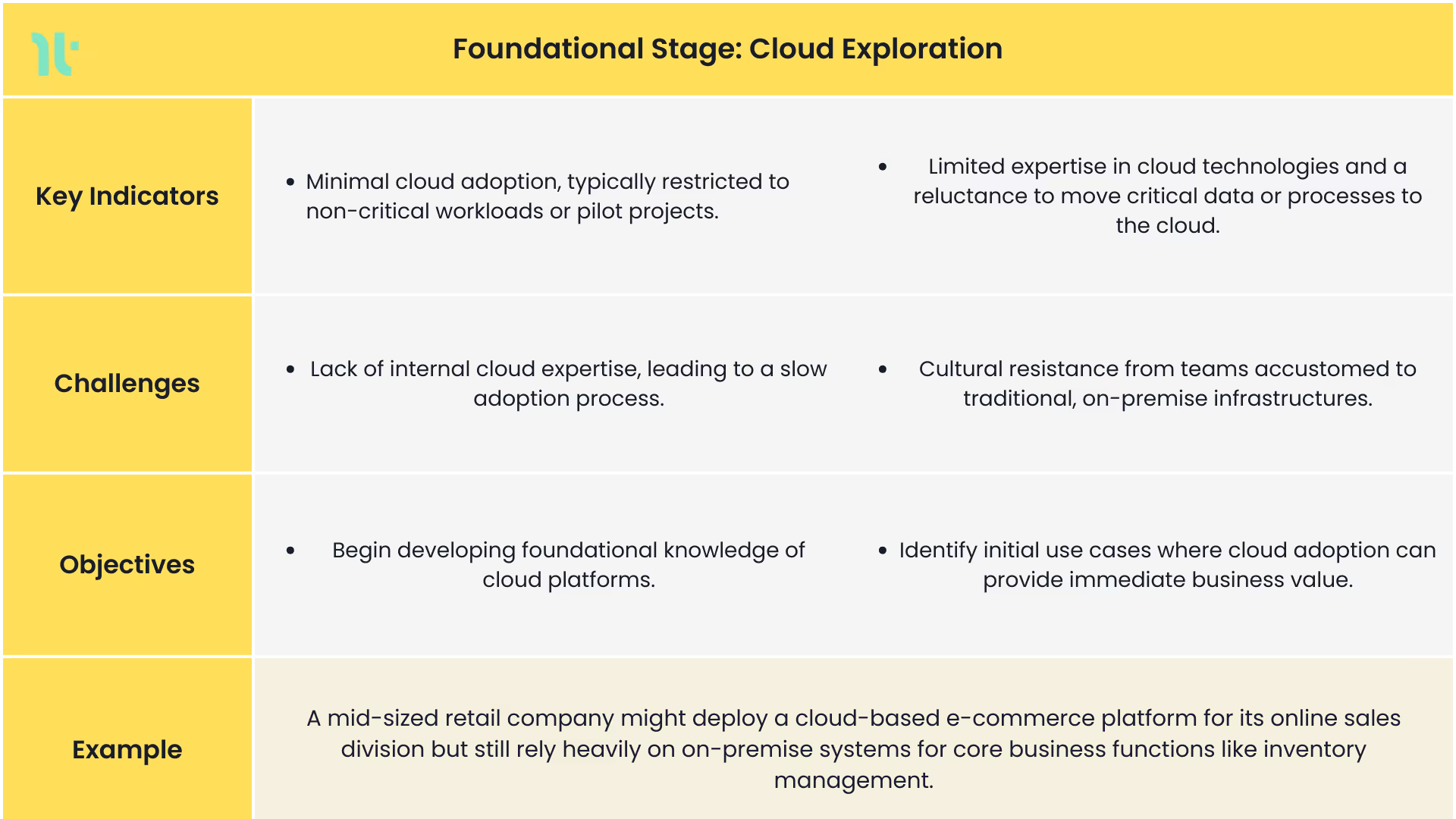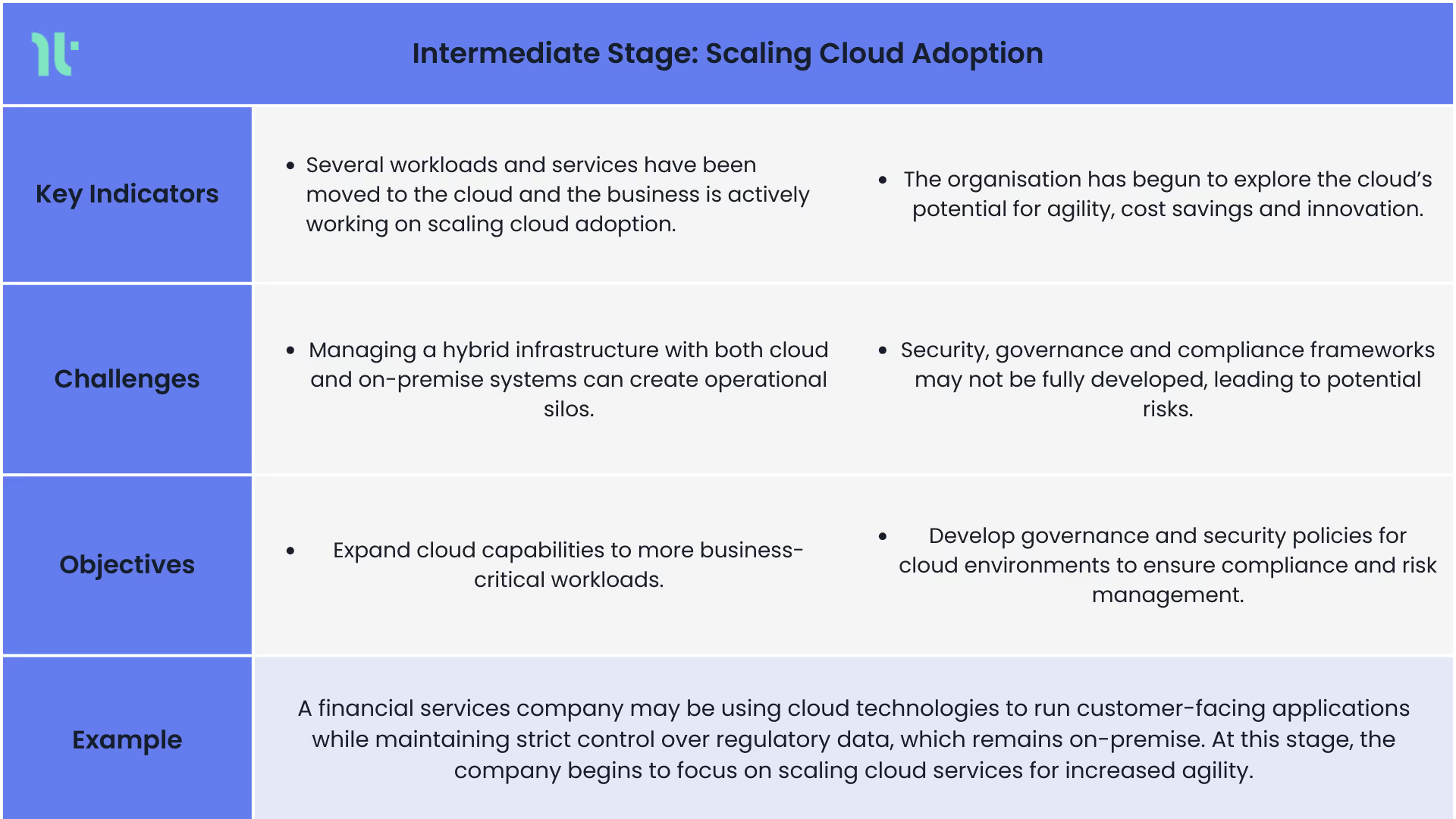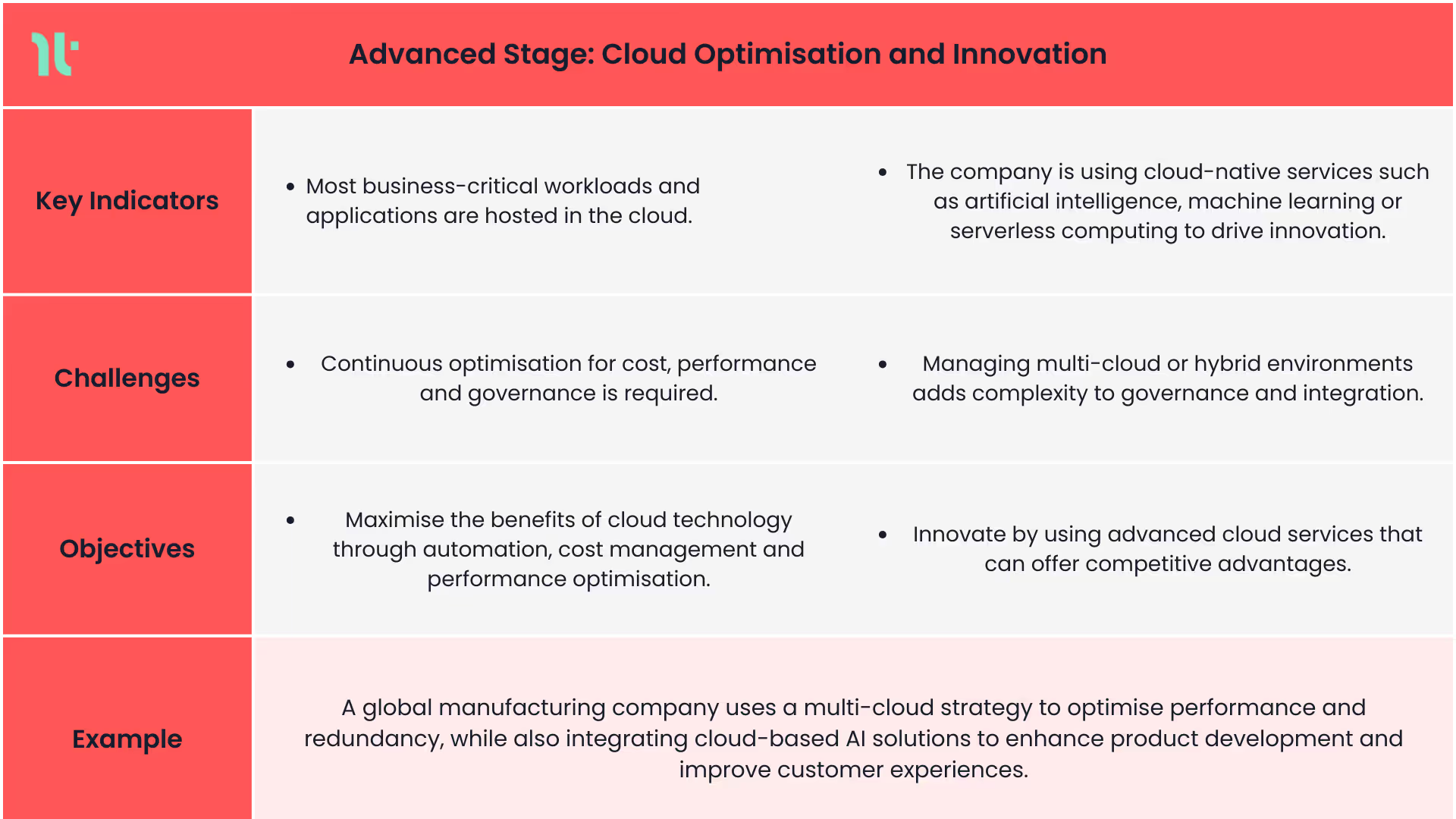

Read Time:
8
Minutes
March 17, 2025
An Introduction to the Cloud Maturity Model and Cloud Adoption for Business Leaders
Cloud adoption is no longer a question of if but when for most businesses. However, the journey to achieving a mature cloud infrastructure is often met with challenges, such as managing costs, ensuring security and compliance, optimising workloads and aligning cloud strategies with business goals. Many organisations struggle with a lack of expertise, cultural shifts and resistance to change, which can complicate their cloud journey and hinder seamless integration into their operations.
As cloud computing technologies like Amazon Web Services (AWS), Google Cloud Platform and Microsoft Azure rapidly emerged in the late 2000s, businesses needed a systematic approach to track their cloud transformation. This is where the Cloud Maturity Model (CMM) became essential. In this blog, we highlight the importance of the CMM in helping business leaders strategically assess and navigate through the different stages of cloud adoption.
What is the Cloud Maturity Model?
The CMM can precisely answer ‘How should a journey to cloud assessment and hybrid IT look like’ for cloud adopters of all levels, from beginners to mid-level to experienced.
The Open Alliance for Cloud Adoption (OACA) defines CMM as:
‘A framework for identifying specific solutions to enterprise cloud/hybrid IT adoption.’
According to the OACA, the CMM is a structured tool designed to offer a roadmap for cloud and hybrid IT adoption. It highlights the gaps in an organisation’s current cloud strategy and provides a framework for identifying the capabilities required to reach specific maturity levels.
More than just a technical assessment, the CMM aligns cloud adoption efforts with broader business objectives, ensuring that cloud strategies are optimised to support both operational efficiency and technical innovation. It encompasses people, processes and technology to address key quality concepts such as scalability, resiliency, availability, security and DevOps.
The CMM outlines several maturity stages, each reflecting a different level of cloud adoption: from initial experimentation with cloud services to fully optimised and automated environments. A critical function of the CMM is to perform a gap analysis—a process that evaluates the distance between a company’s current cloud maturity and its target maturity level. This allows businesses to identify specific areas that need improvement, whether they are in technology, processes or people.
At each stage, businesses encounter specific opportunities and challenges that not only shape their technical cloud adoption but also influence their ability to stay competitive, enhance their responsiveness to market changes and streamline their operations. As organisations progress through these stages, the impact extends far beyond IT, prompting a transformation in how the business functions and adapts.
The CMM achieves this by pushing companies to think beyond the immediate benefits of cloud solutions, such as cost savings and basic scalability, and to consider long-term gains like sustained innovation. How does cloud adoption enable deeper collaboration across departments? How does it unlock new revenue streams or create more personalised customer experiences? Each stage of the model demands introspection, requiring organisations to align their cloud journey with their larger business ambitions.
Don’t worry, this process doesn’t have to be as daunting as it sounds. Ntegra’s ‘Cloud Strategy and Cloud Maturity Model’ is a proven tool that supports businesses at all levels of cloud adoption, from beginners exploring cloud possibilities to advanced users looking to optimise their cloud strategies.
Contact us at hello@ntegra.co.uk to see how Ntegra's Cloud experts can guide your organisation through a seamless cloud transformation.
The Three Stages of Cloud Adoption
The first step in leveraging the CMM is education—ensuring that stakeholders and teams understand the different levels of cloud maturity and the components that make up a cloud adoption strategy. Once an organisation has a clear understanding of its current cloud capabilities and maturity level, it becomes much easier to develop a strategic roadmap for cloud adoption and achieve its business goals.
Generally, in our experience, we find that there are three stages of cloud adoption maturity and businesses fall into one of the following adopter groups: Foundational, Intermediate and Advanced.
Foundational
The Foundational stage is the start of an organisation’s cloud transformation journey, where they envision the cloud but have only just started to consume it.

Intermediate
The Intermediate stage is the mid-phase of an organisation’s cloud transformation, they have cloud operational knowledge, with some cloud workloads and services.

Advanced
The Advanced stage is the end phase of an organisation’s cloud transformation maturity, they have significant cloud operational experience and have been running cloud workloads and services for some time.

Although each cloud transformation is unique to your organisation, the following table consists of some common challenges to be addressed and overcome within each adoption stage.

A mature cloud environment can be described as one where organisations have fully harnessed the efficiencies and opportunities provided by cloud technology. A key indicator of cloud maturity is when the business has seamlessly incorporated cloud services into its overall IT strategy, achieving the desired levels of optimisation, innovation and scalability that align with its business objectives.
Often organisations struggle to reach a mature cloud status and don’t fully adopt cloud technologies and services. This is often not related to the technologies or services themselves, but more to the strong beliefs and organisational approaches built on supporting on-premise capabilities. A secure, holistic approach that addresses people, processes and technology is necessary for a successful cloud adoption.
Focusing primarily on cloud technologies and capabilities only frequently results in less mature cloud assessment and readiness outcomes. Without adapting operational and business mindsets, it is difficult to establish the framework and planning approach necessary to achieve successful cloud adoption and mature cloud status.
The Importance of Cloud Maturity Assessment
An organisation’s current cloud adoption maturity level will be identified through the cloud maturity assessment –we (Ntegra) recommend completing this as the first step. It helps businesses understand their current state of cloud adoption, identify gaps and develop a roadmap for achieving higher levels of cloud maturity.
Conducting regular, structured assessments is crucial for organisations at every stage of adoption. The goals of a cloud maturity assessment can include and are not limited to the following:
- Prioritising Cloud Adoption: The Cloud Maturity Model (CMM) helps organisations manage their cloud adoption priorities and infrastructure.
- Security: Security is a key part of the assessment process to ensure the safety and reliability of the software and infrastructure.
- Planning Cloud Migration: Once the cloud maturity level is defined, organisations can plan their cloud migration, including moving apps and data to the cloud.
- Compliance: Cloud maturity models can introduce new compliance and safety risks, so organisations must ensure they comply with all relevant guidelines and implement strong security measures.
- Governance: IT organisations need to commit to transforming their governance, technology, applications and management processes to better adopt public cloud services.
In more mature organisations, completing the maturity assessment will enable your business to confirm your maturity expectations, enabling informed planning. Within organisations that are less mature, or are only just starting their cloud transformation journey, the assessment provides holistic approaches to identify, address and mature your people, process and technology aspects and goals.
Cloud maturity is not a static achievement; it is multi-faceted and requires continuous monitoring, assessment and optimisation. Regular assessments help businesses stay ahead by continuously improving their cloud infrastructure, ensuring they leverage the latest advancements in cloud technologies.
Ntegra’s Cloud Centre of Excellence (CCoE) offers a comprehensive approach to help you assess and enhance your cloud capabilities across people, processes and technology. Our highly accredited experts are dedicated to guiding you toward a mature, optimised cloud environment that aligns with your long-term operational and business goals. Connect with us at hello@ntegra.co.uk to learn how we can support your cloud journey with tailored solutions.
Co-Authored by Anusha Gurung (Technical Research Analyst) and Shawn Wright (Principal Cloud Consultant).

